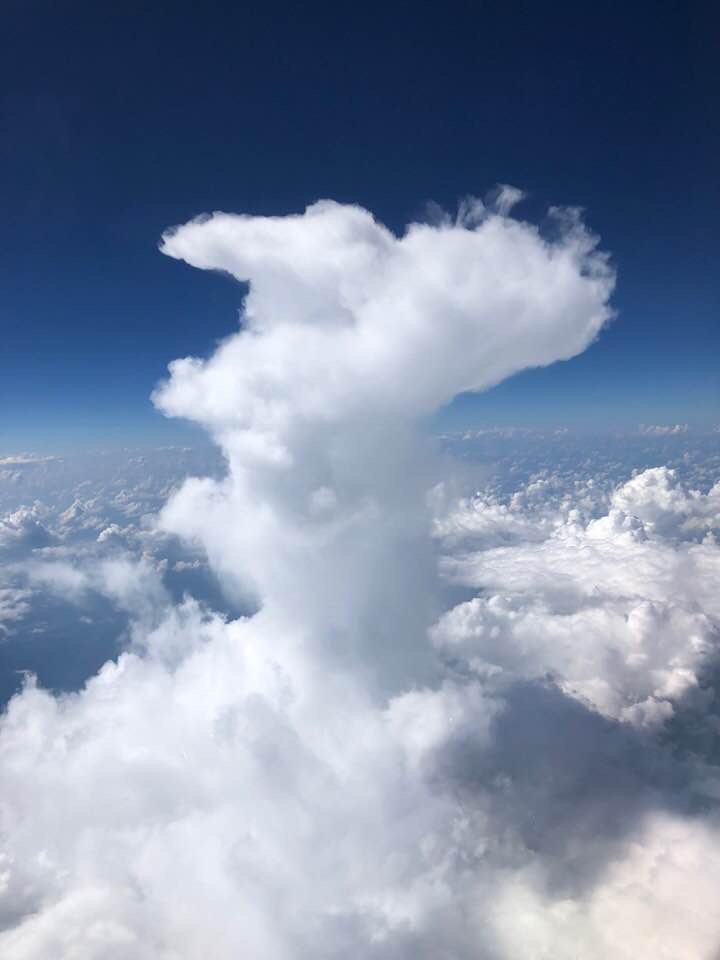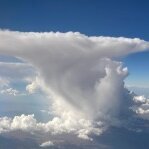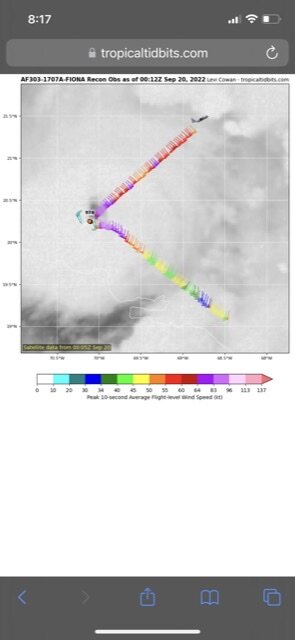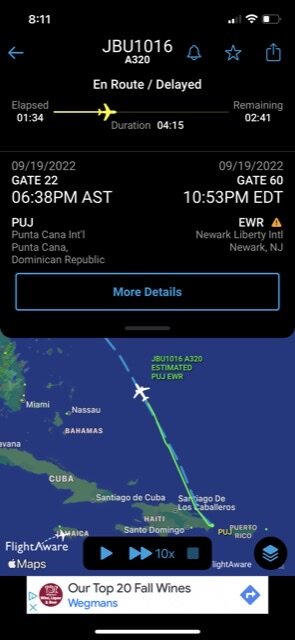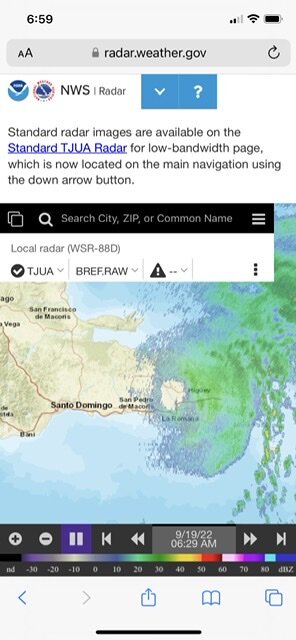-
Posts
2,048 -
Joined
-
Last visited
Content Type
Profiles
Blogs
Forums
American Weather
Media Demo
Store
Gallery
Everything posted by Tatamy
-
Strongest wind gust that I have found on the island so far has been a gust to 99 mph on the west end of the island. This has been measured within the past 10 minutes at a Davis station.
-
1 mph = 1.609344 kph The KPH number south of Nova Scotia would translate to 120 mph.
-
Incredible. A near 921 mb hurricane landfalling in Nova Scotia and 12 hours later it is still drifting in the area with a pressure of 942mb. This would be amazing if it hit Belize or another part of the Yucatán Peninsula. However it is coming ashore at 46N. No words.
-
06z Euro has the same scenario. Pressure at landfall is 935mb on the GFS and 928mb on the Euro.
-
06z GFS has the storm making landfall in eastern Nova Scotia / Cape Breton Island at 75 hours and basically parks it or moves very slowly in the vicinity for upwards of 12 - 15 hours. This is highly unusual in that in the majority of cases these storms rip through that area in 3 - 6 hours. This is going to lead to potential mass destruction in that region.
-
Expected pressure at landfall: 12z Euro is at 932mb 12z GFS is at 928mb 12z CMC is at 942mb These are all at 96 hours with the storm at Nova Scotia/ Cape Breton Island. Euro first saw this possibility early Saturday.
-
-
-
It’s not just the track over the eastern part of the DR. The mountains over the central part of Hispaniola are upwards of 10000 feet in elevation. Air descending down the slopes of these mountains dries out and gets ingested into the circulations of these TC’s and inhibits reorganization and restrengthening. Not this time. Wow.
-
I have been tracking hurricanes since 1971. In that time period I have never seen a storm cross the full length of the DR and look like this only a few short hours later after emerging into the Atlantic. This is quite spectacular to watch unfold.
-
-
Nova Scotia hits 0z Euro 0z CMC
-
0z Euro takes Fiona into Nova Scotia at 174 hrs. 937mb central pressure at that time with impacts spreading into Maine.
-
You are going to need a meridional flow pattern with a big east central deep US trough if you are looking for this to come up the coast. No ensemble support for this currently. As SnoSki 14 said this thing is likely gone once it passes through or even east of the Bahamas (assuming it crosses Hispaniola).
-
0z Euro crosses NW across Hispaniola and then slowly moves just north of eastern Cuba and through the eastern Bahamas. It then moves off in the general direction of the Carolinas while intensifying to a 966 mb hurricane. At 240 hours it is centered south of Cape Hatteras and due east of Jacksonville. Slow mover.
-
FYI - There is a separate thread for Fiona under Tropical Headquarters…
- 1,529 replies
-
- 1
-

-
- hurricane
- tropical storm
-
(and 1 more)
Tagged with:
-
I like the idea of the system really struggling in the short term with a new center developing under or closer to the deeper convection.
-
List of known / suspected hurricanes / tropical cyclones that affected the New York Region in the 1600's / 1700's / 1800's. List of New York hurricanes From Wikipedia, the free encyclopedia Jump to navigationJump to search Track map of all storms known to have made landfall in the state of New York Eighty-five tropical or subtropical cyclones have affected the state of New York since the 17th century. The state of New York is located along the East Coast of the United States, in the Northeastern portion of the country. The strongest of these storms was the 1938 New England hurricane, which struck Long Island as a Category 3 storm on the Saffir–Simpson hurricane scale. Killing more than 60 people, it was also the deadliest. Tropical cyclones have affected the state primarily in September but have also hit during every month of the hurricane season, June through November. Tropical cyclones rarely make landfall on the state, although it is common for remnants of tropical cyclones to produce heavy rainfall and flooding. Contents 1Before 1800 21800–1899 31900–1949 41950–1974 51975–1999 62000–2009 72010–2019 82020–present 9Listed by month 10Deadly storms 11See also 12References 13External links Before 1800[edit] Between 1278 and 1438: A major hurricane struck the modern-day New York/New Jersey area.[1] August 25, 1635: A hurricane that is reported to have tracked parallel to the East Coast impacts New England and New York, although it remains unknown if any damage occurred.[2] September 8, 1667: A 'severe storm' is reported in Manhattan and is reported to be a continuation of a powerful hurricane which affected the Mid-Atlantic.[2] October 29, 1693: The Great Storm of 1693 causes severe damage on Long Island, and is reported to create the Fire Island Cut as a result of the coast-changing storm surge and waves.[2][3] September 23, 1785: Several large ships crash into Governors Island as a result of powerful waves which are reported to have been generated by a tropical cyclone.[3] August 19, 1788: A hurricane strikes New York City or Long Island and is reported to have left the west side of the Battery "laid in ruins" after severe flooding occurs.[3] 1800–1899[edit] Estimated track of the 1821 Norfolk and Long Island hurricane October 9, 1804: Heavy snow falls in Eastern New York peaking at 30 inches (75 cm) as a hurricane tracks northward along the East Coast and becomes extratropical, as cold air fed into the system.[4] September 5, 1815: A hurricane tracks over North Carolina and parallels the East Coast before producing a heavy rainstorm in New York.[5] September 24, 1815: Several hundred trees fall and the majority of the fruit was stripped off apple trees just prior to harvesting time after a hurricane makes landfall on Long Island.[6] September 16, 1816: A possible hurricane strikes New York City, but damage remains unknown.[2] August 9, 1817: A tropical storm produces heavy rainfall in New York City and Long Island.[2] September 3, 1821: The 1821 Norfolk and Long Island hurricane results in severe damage on Long Island and is accompanied by storm surge of 13 feet (4 m). High wind causes a ship to crash on Long Island killing 17 people.[7] June 4, 1825: A hurricane moves off the East Coast and tracks south of New York causing several ship wrecks, and killing seven people.[3] August 27, 1827: High tides are reported in New York City which are caused by a hurricane offshore.[8] August 1, 1830: A hurricane passes to the east of New York and produces gale-force winds to New York City and Long Island.[9] October 4, 1841: Gale–force winds affect New York City as a hurricane tracks north along the East Coast of the United States. Damage is estimated at $2 million (1841 USD, $41 million 2007 USD).[10] October 13, 1846: The Great Havana Hurricane of 1846 tracks inland, causing some damage to New York City.[3] October 6, 1849: Severe structural damage occurs in New York City and Long Island with the passage of a hurricane to the east.[3] July 19, 1850: A hurricane destroys a Coney Island bath house and causes heavy rain, although damage is unknown.[3] This storm destroyed the ship Elizabeth off Fire Island and drowned American transcendentalist Margaret Fuller. August 24, 1850: A storm that is reported to be a hurricane affects New York and New England although there is no known damage.[2] September 9, 1854: A hurricane brushes the East Coast from Florida to New England causing rain on Long Island.[3] September 16, 1858: Low barometric pressure of 28.87 inches mercury at Sag Harbor is reported, and is thought to be associated with a tropical cyclone which causes no known damage.[3] September 6, 1869: A category 3 hurricane makes landfall in Rhode Island and brushes Long Island, which is affected by rain, although minimal damage resulted from the storm.[3] October 28, 1872: A tropical storm passes over New York City and Long Island.[11] October 1, 1874: New York City and the Hudson Valley receives rainfall after a minimal tropical storm tracked over Eastern New York.[11] September 19, 1876: The remnants of the San Felipe hurricane track over western New York State, although damage is unknown.[11] October 24, 1878: The state is affected by tropical storm-force winds and heavy rain with the passage of a hurricane, which made landfall in Virginia.[11][12] August 22, 1888: A tropical storm tracks over New York City before tracking north along the East Coast of the United States.[11] August 24, 1893: Hog Island is washed away by strong storm surge associated with a tropical storm of unknown strength.[3] According to HURDAT, this was a Category 1 hurricane that struck the western end of the Rockaway Peninsula, passing through Brooklyn as a weakening hurricane. Manhattan Island saw gale-force winds to 56 mph. August 29, 1893: | Sea Islands hurricane moves thorough the Hudson Valley as a tropical storm.[13] Lives were lost in the Rockaways and when tow boats were destroyed at various points along the Hudson River. Roofs, structures, boats and crops were destroyed or damaged from Brooklyn to as far west as Dunkirk. Winds of 54 and 57 MPH recorded in New York and Albany respectively.[14][15] October 10, 1894: 10 People were killed and 15 injured at 74 Monroe Street in Manhattan when winds blew a building under construction onto a tenement crushing it. Extensive damage in the NYC and Long Island to telegraph lines, trees and boats docked on shore. Storm formed over Gulf of Mexico as a Category 3 weakened over land in the Southeast and re strengthened to a Category 1 over the Chesapeake Bay before striking Long Island.[16][17]
- 1,529 replies
-
- 4
-

-

-
- hurricane
- tropical storm
-
(and 1 more)
Tagged with:
-
This system will be a dying tropical storm as it moves through the area as shown on this run with the heaviest rains to the south and west.
- 1,529 replies
-
- hurricane
- tropical storm
-
(and 1 more)
Tagged with:
-
1.16” at my station at Cherry Grove on Fire Island. Two other nearby stations had even higher amounts (WU).
- 1,529 replies
-
- hurricane
- tropical storm
-
(and 1 more)
Tagged with:
-
Total here yesterday was 1.02”. Waiting for the skies to open up currently.
- 1,529 replies
-
- hurricane
- tropical storm
-
(and 1 more)
Tagged with:
-
It’s been a rainy one out here since before sunrise. Have received 0.72” so far today.
- 1,529 replies
-
- 1
-

-
- hurricane
- tropical storm
-
(and 1 more)
Tagged with:
-
I recorded 0.22” at my station at Cherry Grove on Fire Island with this event.
- 1,529 replies
-
- hurricane
- tropical storm
-
(and 1 more)
Tagged with:
-
Event total up to 2.13” here.
- 1,529 replies
-
- hurricane
- tropical storm
-
(and 1 more)
Tagged with:

